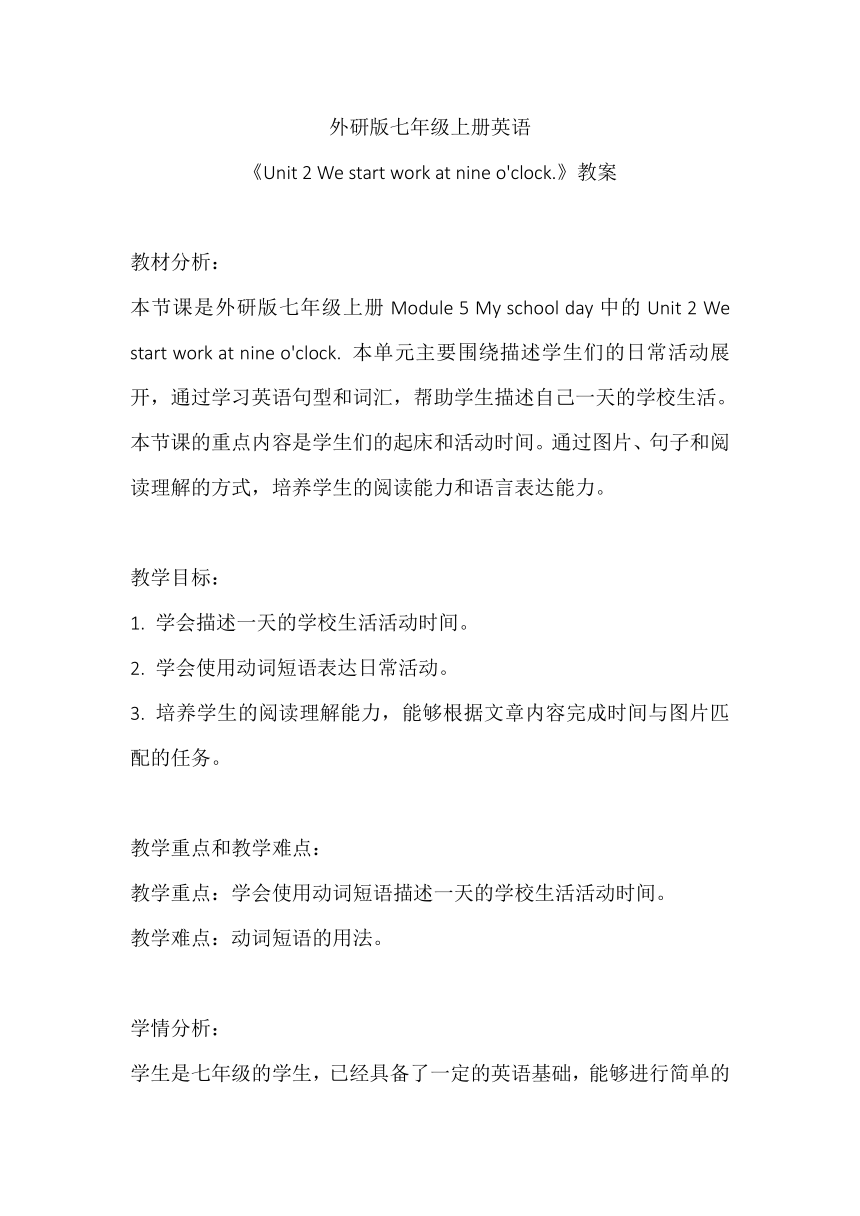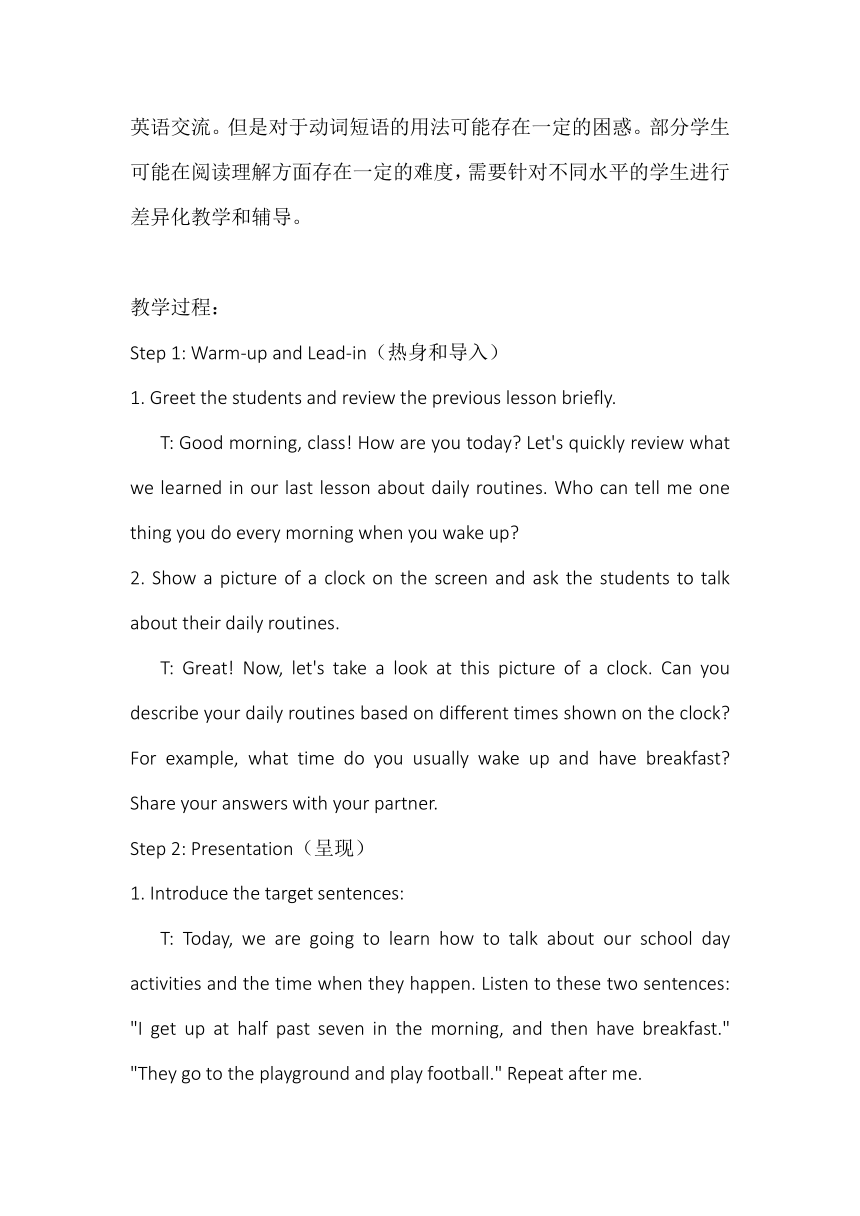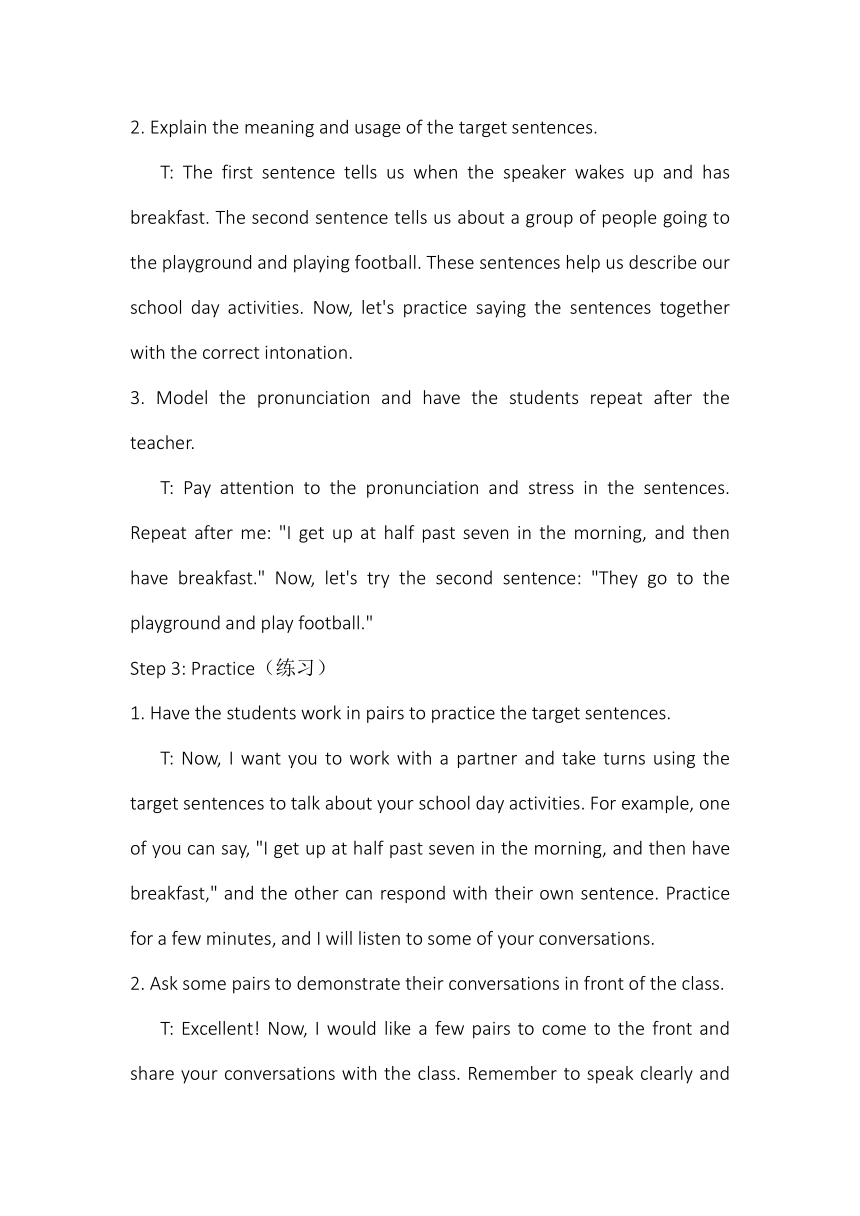Module 5 My school day Unit 2 We start work at nine o'clock. 教案
文档属性
| 名称 | Module 5 My school day Unit 2 We start work at nine o'clock. 教案 |  | |
| 格式 | docx | ||
| 文件大小 | 13.7KB | ||
| 资源类型 | 教案 | ||
| 版本资源 | 外研版 | ||
| 科目 | 英语 | ||
| 更新时间 | 2023-12-28 17:25:59 | ||
图片预览



文档简介
外研版七年级上册英语
《Unit 2 We start work at nine o'clock.》教案
教材分析:
本节课是外研版七年级上册Module 5 My school day中的Unit 2 We start work at nine o'clock. 本单元主要围绕描述学生们的日常活动展开,通过学习英语句型和词汇,帮助学生描述自己一天的学校生活。本节课的重点内容是学生们的起床和活动时间。通过图片、句子和阅读理解的方式,培养学生的阅读能力和语言表达能力。
教学目标:
1. 学会描述一天的学校生活活动时间。
2. 学会使用动词短语表达日常活动。
3. 培养学生的阅读理解能力,能够根据文章内容完成时间与图片匹配的任务。
教学重点和教学难点:
教学重点:学会使用动词短语描述一天的学校生活活动时间。
教学难点:动词短语的用法。
学情分析:
学生是七年级的学生,已经具备了一定的英语基础,能够进行简单的英语交流。但是对于动词短语的用法可能存在一定的困惑。部分学生可能在阅读理解方面存在一定的难度,需要针对不同水平的学生进行差异化教学和辅导。
教学过程:
Step 1: Warm-up and Lead-in(热身和导入)
1. Greet the students and review the previous lesson briefly.
T: Good morning, class! How are you today Let's quickly review what we learned in our last lesson about daily routines. Who can tell me one thing you do every morning when you wake up
2. Show a picture of a clock on the screen and ask the students to talk about their daily routines.
T: Great! Now, let's take a look at this picture of a clock. Can you describe your daily routines based on different times shown on the clock For example, what time do you usually wake up and have breakfast Share your answers with your partner.
Step 2: Presentation(呈现)
1. Introduce the target sentences:
T: Today, we are going to learn how to talk about our school day activities and the time when they happen. Listen to these two sentences: "I get up at half past seven in the morning, and then have breakfast." "They go to the playground and play football." Repeat after me.
2. Explain the meaning and usage of the target sentences.
T: The first sentence tells us when the speaker wakes up and has breakfast. The second sentence tells us about a group of people going to the playground and playing football. These sentences help us describe our school day activities. Now, let's practice saying the sentences together with the correct intonation.
3. Model the pronunciation and have the students repeat after the teacher.
T: Pay attention to the pronunciation and stress in the sentences. Repeat after me: "I get up at half past seven in the morning, and then have breakfast." Now, let's try the second sentence: "They go to the playground and play football."
Step 3: Practice(练习)
1. Have the students work in pairs to practice the target sentences.
T: Now, I want you to work with a partner and take turns using the target sentences to talk about your school day activities. For example, one of you can say, "I get up at half past seven in the morning, and then have breakfast," and the other can respond with their own sentence. Practice for a few minutes, and I will listen to some of your conversations.
2. Ask some pairs to demonstrate their conversations in front of the class.
T: Excellent! Now, I would like a few pairs to come to the front and share your conversations with the class. Remember to speak clearly and use the target sentences we learned.
Step 4: Reading Comprehension(阅读理解)
1. Distribute the reading passage to the students.
T: It's time for us to read a short passage about a school day. Here is a reading passage for each of you. Please read it silently.
2. Read the passage aloud as a class.
T: Now, let's read the passage aloud together as a class. Pay attention to the pronunciation and intonation.
3. Ask the students to read the passage silently and answer the questions.
T: Please read the passage again silently and answer the questions on the worksheet. Take your time, and raise your hand when you're finished.
4. Check the answers as a class and discuss the correct answers.
T: Let's go through the questions together, and I will ask some of you to share your answers. If you have any questions, feel free to ask.
Step 5: Consolidation(巩固)
1. Review the target sentences and their meanings.
T: Let's review the target sentences we learned today. Repeat after me: "I get up at half past seven in the morning, and then have breakfast." "They go to the playground and play football." What do these sentences mean
2. Have the students create their own sentences using the target phrases.
T: Now, I want you to think of your own sentences using the target phrases. Write down at least two sentences describing your school day activities. After that, share your sentences with a partner and discuss your daily routines.
Step 6: Summary and Homework(总结和作业)
1. Summarize the key points of the lesson and check if the students have achieved the learning objectives.
T: Today, we learned how to talk about our school day activities and the time when they happen. We practiced using the sentences "I get up at half past seven in the morning, and then have breakfast" and "They go to the playground and play football." Can someone tell me when you usually get up and have breakfast
2. Assign homework: Ask the students to write a short paragraph about their school day using the target phrases learned in class.
T: For homework, I want you to write a short paragraph describing your school day activities. Use the target phrases we learned today. Be creative and write at least five sentences. You can include otherdetails such as subjects you study, lunchtime, and extracurricular activities. Remember to use the correct time expressions. The paragraph should be submitted at the beginning of our next class.
3. Provide any necessary clarifications and answer any questions the students may have.
4. End the lesson with a positive note.
T: Great job today, everyone! I'm impressed with your participation and progress. Keep practicing and using the target phrases in your daily life. I look forward to reading your paragraphs in the next class. Have a wonderful day!
板书设计:
Unit 2 We start work at nine o'clock.
- I get up at half past seven in the morning, and then have breakfast.
- They go to the playground and play football.
教学反思:
本节课通过引入目标句子,让学生学会描述一天的学校生活活动时间,并通过阅读理解训练提高学生的阅读能力。教学过程中,教师注重口语练习和学生的参与,激发了学生的学习兴趣。针对不同水平的学生,进行了差异化教学,帮助他们理解和掌握动词短语的用法。在教学过程中及时给予学生反馈,鼓励他们互相交流和表达。通过本节课的教学,学生们能够更好地描述自己的一天学校生活,并提高了阅读理解的能力。
《Unit 2 We start work at nine o'clock.》教案
教材分析:
本节课是外研版七年级上册Module 5 My school day中的Unit 2 We start work at nine o'clock. 本单元主要围绕描述学生们的日常活动展开,通过学习英语句型和词汇,帮助学生描述自己一天的学校生活。本节课的重点内容是学生们的起床和活动时间。通过图片、句子和阅读理解的方式,培养学生的阅读能力和语言表达能力。
教学目标:
1. 学会描述一天的学校生活活动时间。
2. 学会使用动词短语表达日常活动。
3. 培养学生的阅读理解能力,能够根据文章内容完成时间与图片匹配的任务。
教学重点和教学难点:
教学重点:学会使用动词短语描述一天的学校生活活动时间。
教学难点:动词短语的用法。
学情分析:
学生是七年级的学生,已经具备了一定的英语基础,能够进行简单的英语交流。但是对于动词短语的用法可能存在一定的困惑。部分学生可能在阅读理解方面存在一定的难度,需要针对不同水平的学生进行差异化教学和辅导。
教学过程:
Step 1: Warm-up and Lead-in(热身和导入)
1. Greet the students and review the previous lesson briefly.
T: Good morning, class! How are you today Let's quickly review what we learned in our last lesson about daily routines. Who can tell me one thing you do every morning when you wake up
2. Show a picture of a clock on the screen and ask the students to talk about their daily routines.
T: Great! Now, let's take a look at this picture of a clock. Can you describe your daily routines based on different times shown on the clock For example, what time do you usually wake up and have breakfast Share your answers with your partner.
Step 2: Presentation(呈现)
1. Introduce the target sentences:
T: Today, we are going to learn how to talk about our school day activities and the time when they happen. Listen to these two sentences: "I get up at half past seven in the morning, and then have breakfast." "They go to the playground and play football." Repeat after me.
2. Explain the meaning and usage of the target sentences.
T: The first sentence tells us when the speaker wakes up and has breakfast. The second sentence tells us about a group of people going to the playground and playing football. These sentences help us describe our school day activities. Now, let's practice saying the sentences together with the correct intonation.
3. Model the pronunciation and have the students repeat after the teacher.
T: Pay attention to the pronunciation and stress in the sentences. Repeat after me: "I get up at half past seven in the morning, and then have breakfast." Now, let's try the second sentence: "They go to the playground and play football."
Step 3: Practice(练习)
1. Have the students work in pairs to practice the target sentences.
T: Now, I want you to work with a partner and take turns using the target sentences to talk about your school day activities. For example, one of you can say, "I get up at half past seven in the morning, and then have breakfast," and the other can respond with their own sentence. Practice for a few minutes, and I will listen to some of your conversations.
2. Ask some pairs to demonstrate their conversations in front of the class.
T: Excellent! Now, I would like a few pairs to come to the front and share your conversations with the class. Remember to speak clearly and use the target sentences we learned.
Step 4: Reading Comprehension(阅读理解)
1. Distribute the reading passage to the students.
T: It's time for us to read a short passage about a school day. Here is a reading passage for each of you. Please read it silently.
2. Read the passage aloud as a class.
T: Now, let's read the passage aloud together as a class. Pay attention to the pronunciation and intonation.
3. Ask the students to read the passage silently and answer the questions.
T: Please read the passage again silently and answer the questions on the worksheet. Take your time, and raise your hand when you're finished.
4. Check the answers as a class and discuss the correct answers.
T: Let's go through the questions together, and I will ask some of you to share your answers. If you have any questions, feel free to ask.
Step 5: Consolidation(巩固)
1. Review the target sentences and their meanings.
T: Let's review the target sentences we learned today. Repeat after me: "I get up at half past seven in the morning, and then have breakfast." "They go to the playground and play football." What do these sentences mean
2. Have the students create their own sentences using the target phrases.
T: Now, I want you to think of your own sentences using the target phrases. Write down at least two sentences describing your school day activities. After that, share your sentences with a partner and discuss your daily routines.
Step 6: Summary and Homework(总结和作业)
1. Summarize the key points of the lesson and check if the students have achieved the learning objectives.
T: Today, we learned how to talk about our school day activities and the time when they happen. We practiced using the sentences "I get up at half past seven in the morning, and then have breakfast" and "They go to the playground and play football." Can someone tell me when you usually get up and have breakfast
2. Assign homework: Ask the students to write a short paragraph about their school day using the target phrases learned in class.
T: For homework, I want you to write a short paragraph describing your school day activities. Use the target phrases we learned today. Be creative and write at least five sentences. You can include otherdetails such as subjects you study, lunchtime, and extracurricular activities. Remember to use the correct time expressions. The paragraph should be submitted at the beginning of our next class.
3. Provide any necessary clarifications and answer any questions the students may have.
4. End the lesson with a positive note.
T: Great job today, everyone! I'm impressed with your participation and progress. Keep practicing and using the target phrases in your daily life. I look forward to reading your paragraphs in the next class. Have a wonderful day!
板书设计:
Unit 2 We start work at nine o'clock.
- I get up at half past seven in the morning, and then have breakfast.
- They go to the playground and play football.
教学反思:
本节课通过引入目标句子,让学生学会描述一天的学校生活活动时间,并通过阅读理解训练提高学生的阅读能力。教学过程中,教师注重口语练习和学生的参与,激发了学生的学习兴趣。针对不同水平的学生,进行了差异化教学,帮助他们理解和掌握动词短语的用法。在教学过程中及时给予学生反馈,鼓励他们互相交流和表达。通过本节课的教学,学生们能够更好地描述自己的一天学校生活,并提高了阅读理解的能力。
同课章节目录
- Starte
- Module 1 My teacher and my friends
- Module 2 My English lesson
- Module 3 My English book
- Module 4 My everyday life
- Module 1 My classmates
- Unit 1 Nice to meet you.
- Unit 2 I'm Wang Lingling and I'm thirteen years ol
- Unit 3 Language in use.
- Module 2 My family
- Unit 1 Is this your mum?
- Unit 2 These are my parents.
- Unit 3 Language in use.
- Module 3 My school
- Unit 1 There are thirty students in my class.
- Unit 2 The library is on the left of the playgroun
- Unit 3 Language in use.
- Module 4 Healthy food
- Unit 1 We've got lots of apples.
- Unit 2 Is your food and drink healthy?
- Unit 3 Language in use.
- Module 5 My school day
- Unit 1 I love history.
- Unit 2 We start work at nine o'clock.
- Unit 3 Language in use.
- Revision module A
- Module 6 A trip to the zoo
- Unit 1 Does it eat meat?
- Unit 2 The tiger lives in Asia.
- Unit 3 Language in use.
- Module 7 Computers
- Unit 1 How do I write my homework on the computer?
- Unit 2 When do you use a computer?
- Unit 3 Language in use.
- Module 8 Choosing presents
- Unit 1 I always like birthday parties.
- Unit 2 She often goes to concerts.
- Unit 3 Language in use.
- Module 9 People and places
- Unit 1 We're enjoying the school trip a lot.
- Unit 2 They're waiting for buses or trains.
- Unit 3 Language in use.
- Module 10 Spring Festival
- Unit 1 Are you getting ready for Spring Festival?
- Unit 2 My mother's cleaning our houses and sweepin
- Unit 3 Language in use.
- Revision module B
